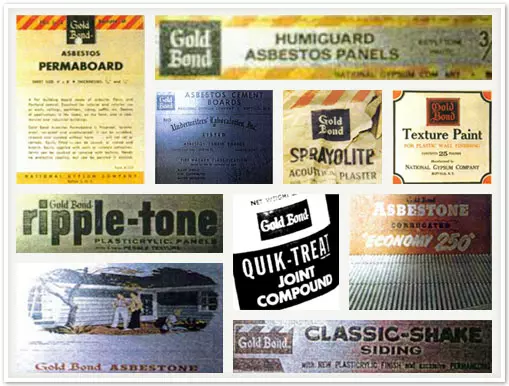01. History of Asbestos Use
National Gypsum History of Asbestos Use
National Gypsum, also known as National Gypsum Company or NGC, was founded in 1925 and remains in business today. The company’s primary focus began with gypsum wallboard. They claimed that their wallboard was lighter, more flexible and higher performing than any other wallboard brand, even stamping their products with a “Gold Bond,” offering $5,000 to anyone who could prove otherwise. Their Gold Bond strategy was trademarked by 1926 and became an alternative brand name for their products.
National Gypsum continued to thrive throughout the next few decades, successfully navigating several patent-infringement lawsuits and emerging from the Great Depression. The asbestos company continued to expand its product line and acquired several other large companies to grow its presence and set of resources.
Universal Gypsum was one of the largest and most important acquisitions, as the company was one of their main competitors and twice the size of NGC. National Gypsum Company gained gypsum plants in Texas, Iowa, Pennsylvania and New York, along with several other mines and a strong presence in the Midwest. Though NGC did experience some losses, particularly during the Great Depression, they continued to borrow and raise money, exchange stocks and strategically target different products to maintain their role as a major construction product supplier.
Resources for Mesothelioma Patients
02. Asbestos Products
National Gypsum Asbestos Products
Construction products produced from the 1920s – 1970s are known to have likely contained asbestos. The inexpensive mineral offered resistance to fire, chemicals and heat, while also offering durability; all of which are conditions ideal for building materials.

Specific brand-name products from National Gypsum that have been linked to asbestos include Gold Bond Gypsum Board, Gold Bond Abestone, Gold Bond Sprayolite, ProForm Drywall Finishing Products and PermaBase Cement Board. Many NGC asbestos products fall under the brand name Gold Bond, which was popular during the time when asbestos was most commonly used.
03. Occupational Exposure
National Gypsum and Occupational Exposure
As National Gypsum Company’s presence grew, so did their breadth of asbestos exposure. During World War II, NGC manufactured acoustic panels used on aircraft engines, metal landing strips and insulation for cargo ships, all of which were considered highly useful for the Korean and Vietnam wars. National Gypsum became a primary supplier of wallboard across the United States, even struggling to meet the growing demand.
With all of these major projects, asbestos products were exposing workers across various industries and trades. Whenever products were damaged, cut, trimmed, sanded, worn down or disturbed in any way, asbestos fibers could easily become airborne. Once airborne, fibers are then susceptible to inhalation or ingestion, putting individuals at risk of developing diseases like malignant mesothelioma.
National Gypsum was in control of 27% of the gypsum market by 1950 and was producing over 150 building materials during a time when construction was frequent. By the 1930s, the dangers of asbestos were acknowledged and safer alternatives were developed. However, asbestos was a much cheaper option and companies like National Gypsum did not cease asbestos production, continuing to benefit from growing profits. In 1950, NGC reported $75 million in sales.
04. Asbestos Litigation
Asbestos Litigation Against National Gypsum
In the 1960s, National Gypsum started to face a variety of financial hardships. They reached a $19 million settlement in 1973 in a civil suit regarding gypsum manufacturer pricing practices, which then led to further investigation and to a Supreme Court case where NGC was found guilty. The company took on other debts for expansions and had fluctuating profits throughout the next decade. In 1986, their profits reached an all-time low as their legal losses reached an all-time high.
200,000
asbestos victims filed lawsuits against NGC by the early 1990s and filed for Chapter 11 bankruptcy.
In 1987, National Gypsum reached settlements with 155 schools across 19 different states when their asbestos construction products were found in the school buildings. Just two years earlier, NGC also lost to Mercer University after the school had to undergo costly renovations to replace National Gypsum’s asbestos construction materials.
By the early 1990s, around 200,000 asbestos victims had filed lawsuits against asbestos manufacturers. National Gypsum faced around 45,000 of these cases in 1992, as the company continued to produce asbestos products until 1970 when they halted use of the mineral altogether. NGC employees, consumers and affected family members took legal action against the company to gain compensation for a diagnosis resulting from asbestos exposure from NGC products.
05. Asbestos Trust Fund
National Gypsum Asbestos Trust Fund
In 1990, National Gypsum Company filed for Chapter 11 bankruptcy. In July 1993, NGC emerged from the bankruptcy and was replaced by a new company with the same name.
The new National Gypsum ended up creating an asbestos trust fund in 2000 to ensure that they could pay out existing and future personal injury claims. The trust is called the NGC Bodily Injury Trust. Trust fund awards are subject to a certain percentage. This ensures fair distribution of financial assistance to those affected by asbestos in the company’s products.
The current payment percentage for successful claims is 45%.
The current payment percentage for the NGC Bodily Injury Trust is 45%. However, actual payment amounts may vary due to factors like a claimant’s age, exposure type and the company’s asbestos settlement history.
By 2010, The NGC trust had paid out $203 million in property damage claims, personal injury claims and wrongful death claims. The trust continues to accept and pay claims today. If you believe you or a loved one is entitled to compensation, learn how a mesothelioma lawyer can help.









